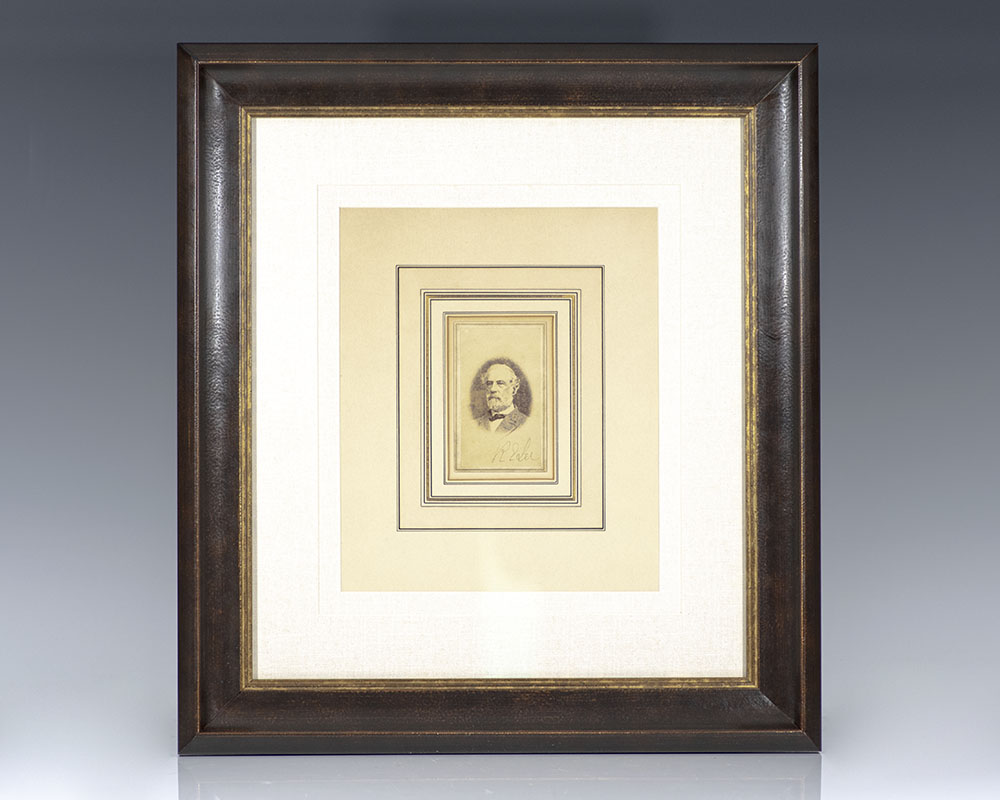Robert E. Lee Signed Carte-de-Visite.
Rare Reconstruction Era Carte-de-visite of Confederate Commander Robert E. Lee; Signed by Him
Robert E. Lee Signed Carte-de-Visite.
LEE, Robert E.
$7,200.00
Item Number: 140513
Lexington, Va: Boude & Miley, [1869].
Rare Reconstruction era carte-de-visite portrait of former Confederate commander General Robert E. Lee in civilian attire, boldly signed “RE Lee.” The carte-de-visite measures 2.5 inches by 4 inches with Boude & Miley’s imprint on the verso. This striking postwar portrait of Lee was captured by photographer Michael Miley of Lexington, Virginia in 1869, perhaps less than a year prior to Lee’s death on October 12, 1870. Following the conclusion of the American Civil War in 1865, Lee became president of Washington College (later Washington and Lee University) in Lexington, Virginia; in that position, he supported reconciliation between North and South.The Trustees used his famous name in large-scale fund-raising appeals and Lee transformed Washington College into a leading Southern college, expanding its offerings significantly, adding programs in commerce and journalism, and incorporating the Lexington Law School. Lee was well liked by the students, which enabled him to announce an “honor system” like that of West Point, explaining that “we have but one rule here, and it is that every student be a gentleman.” To speed up national reconciliation Lee recruited students from the North and made certain they were well treated on campus and in town. In near fine condition. Double matted and framed. The entire piece measures 11.75 inches by 10.25 inches. An excellent portrait with the signature bold.
American Civil War Confederate soldier and general Robert E. Lee commanded the Army of Northern Virginia in the American Civil War from 1862 until his surrender in 1865. A son of Revolutionary War officer Henry "Light Horse Harry" Lee III, Lee was a top graduate of the United States Military Academy and an exceptional officer and military engineer in the United States Army for 32 years. During this time, he served throughout the United States, distinguished himself during the Mexican–American War, and served as Superintendent of the United States Military Academy. Lee took command of the Army of Northern Virginia in June 1862 during the Peninsula Campaign following the wounding of Joseph E. Johnston. He succeeded in driving the Union Army of the Potomac under George B. McClellan away from the Confederate capital of Richmond during the Seven Days Battles, although he was unable to destroy McClellan's army. Lee then overcame Union forces under John Pope at the Second Battle of Bull Run in August. His invasion of Maryland that September ended with the inconclusive Battle of Antietam, after which he retreated to Virginia. Lee won two of his most decisive victories at Fredericksburg and Chancellorsville before launching a second invasion of the North in the summer of 1863, where he was decisively defeated at the Battle of Gettysburg by the Army of the Potomac under George Meade. He led his army in the minor and inconclusive Bristoe Campaign that fall before General Ulysses S. Grant took command of Union armies in the spring of 1864. Grant engaged Lee's army in bloody but inconclusive battles at the Wilderness and Spotsylvania before the lengthy Siege of Petersburg, which was followed in April 1865 by the capture of Richmond and the destruction of most of Lee's army, which he finally surrendered to Grant at Appomattox Court House. After his death in 1870, Lee became a cultural icon in the South and is largely hailed as one of the Civil War's greatest generals. As commander of the Army of Northern Virginia, he fought most of his battles against armies of significantly larger size, and managed to win many of them. Lee built up a collection of talented subordinates, most notably James Longstreet, Stonewall Jackson, and J. E. B. Stuart, who along with Lee were critical to the Confederacy's battlefield success.






